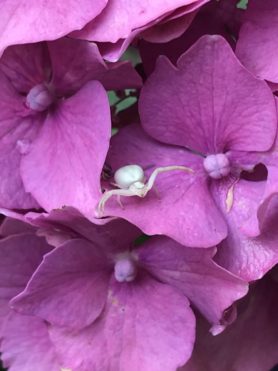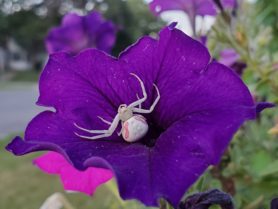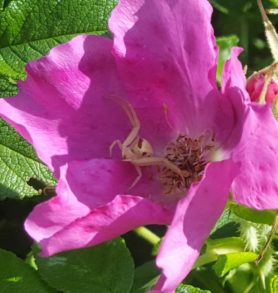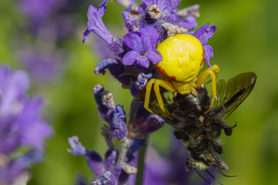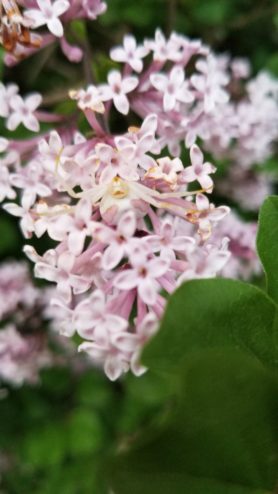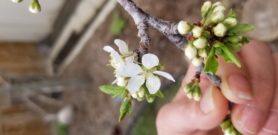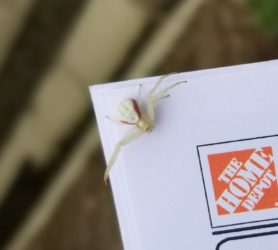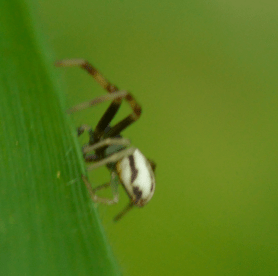Taxonomic Hierarchy
- Kingdom: Animalia
- Phylum: Arthropoda
- Class: Arachnida
- Order: Araneae
- Suborder: Araneomorphae
- Family: Thomisidae
- Genus: Misumena
- Species: Misumena vatia
Common Name (AAS )
)
Golden-rod Crab Spider
Other Common Names
Flower Crab Spider, Yellow Crab Spider, White Crab Spider, Smooth Crab Spider
Author
Carl Alexander Clerck, 1757
Primary Colors
Sightings Overview
There have been 35 confirmed sightings of Misumena vatia (Golden-rod Crab Spider), with the most recent sighting submitted on November 17, 2019 by Spider ID member j_staff99. The detailed statistics below may not utilize the complete dataset of 35 sightings because of certain Misumena vatia sightings reporting incomplete data.
- Web: 24% of the time, Misumena vatia spiders are sighted in a spider web (Sample size: 34)
- Sex: 9 female and 3 male.
- Environment: Misumena vatia has been sighted 35 times outdoors, and 2 times indoors.
- Outdoors: Man-made structure (2). On flower (24). Low foliage (6). High foliage (2). Ground layer (1).
Location and Range
Misumena vatia (Golden-rod Crab Spider) has been sighted in the following countries: Canada, Ireland, United Kingdom, United States.
Misumena vatia has also been sighted in the following states: California, Maine, Massachusetts, Michigan, Minnesota, New Hampshire, New York, Oregon, Utah, Washington, Wisconsin.
Seasonality
Misumena vatia has been primarily sighted during the month of May.
- January:
- February:
- March: 1
- April: 3
- May: 12
- June: 6
- July: 4
- August: 6
- September: 2
- October:
- November:
- December: 1
Additional Remarks
- This spider has crab-like leg posture and gait.
- The front pair of legs are much longer and stronger than the short rear pairs.
- In females the abdomen is widest at the posterior (back) end, appearing as a rounded triangle shape from above; it is also somewhat flattened in a side view.
- Adult males of this species are only about 1/4 to 1/3 the size of the adult females.
- In females, the area in between the eyes is usually a bright color like yellow, orange, or red.
- Goldenrod flowers and milkweed are well-known habitats for this species.
- Because they live and hunt on flowers, the majority of their diet includes pollinators (e.g. bumblebees, honeybees, butterflies, moths, syrphid flies, etc). Males often eat flower pollen to fuel themselves during their quest for mates.
- Primarily daytime feeders, but they’re also known to feed late into the night on warm days when insect activity is high, which suggests they are not solely dependent on their vision for capturing prey.
- This species usually only has one egg sac (brood) in their lifetime. The female will fold over the tip of a leaf and web it together, then deposit her eggs inside the “pocket.” She guards the eggs until her death.
- This is one of the few spiders in North America that are capable of actively changing their body color from yellow to white, or vice versa, depending on the flower they are perched on. They do this by transferring a liquid pigmented material to the cuticle. The color change can take anywhere from one to twenty days to complete, it is not instantaneous.
- The “Goldenrod crab spider” is one of the most well-known and studied species in the world. At least one book, “Predator upon a Flower: Life History and Fitness in a Crab Spider” by Douglass Morse (2007), contains the entire account of almost anything you could ever want to know about the species. Numerous other research papers have been written on such subjects as their ability to change color, their nesting techniques, their vision, their choice of feeding spots, and many other things.
- Related field guide errata: note that in the book “Spiders of the Carolinas” by L.L. Gaddy (2009), there is an image of a male Misumenoides formosipes on page 163 that is labeled incorrectly as a male Misumena vatia. Also in that same book, on the next page, is an image of an immature male Misumena vatia incorrectly labeled as a female Misumenoides formosipes. Additionally, in the book “Spiders of the Eastern United States” by Howell & Jenkins (2004), on page 289, although both images are labeled as Misumena vatia, the top image is actually a female in the genus Mecaphesa (note all the prominent spines on carapace and abdomen) and the bottom image is an adult male Misumenoides formosipes. (If you have this book and are looking at it presently, the adjacent page 288 shows a female species of Xysticus, not a Bassaniana versicolor as it is labeled. There are some additional errors in these books and others, too.)
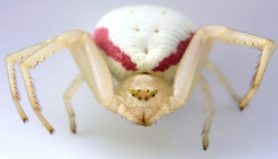 The spider species Misumena vatia, commonly known as Golden-rod Crab Spider, belongs to the genus Misumena, in the family Thomisidae. Misumena vatia spiders have been sighted
The spider species Misumena vatia, commonly known as Golden-rod Crab Spider, belongs to the genus Misumena, in the family Thomisidae. Misumena vatia spiders have been sighted 